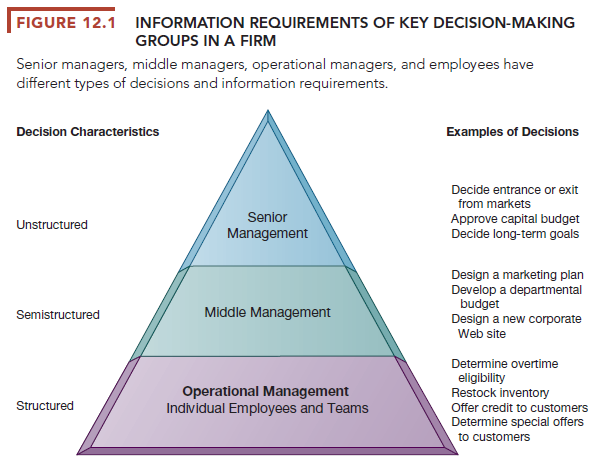Decision making in businesses used to be limited to management. Today, lower- level employees are responsible for some of these decisions, as information systems make information available to lower levels of the business. But what do we mean by better decision making? How does decision making take place in businesses and other organizations? Let’s take a closer look.
1. Business Value of Improved Decision Making
What does it mean to the business to make better decisions? What is the monetary value of improved decision making? Table 12.1 attempts to measure the monetary value of improved decision making for a small U.S. manufacturing firm with $280 million in annual revenue and 140 employees. The firm has identified a number of key decisions where new system investments might improve the quality of decision making. The table provides selected estimates of annual value (in the form of cost savings or increased revenue) from improved decision making in selected areas of the business.
We can see from Table 12.1 that decisions are made at all levels of the firm and that some of these decisions are common, routine, and numerous. Although the value of improving any single decision may be small, improving hundreds of thousands of “small” decisions adds up to a large annual value for the business.

2. Types of Decisions
Chapters 1 and 2 showed that there are different levels in an organization. Each of these levels has different information requirements for decision support and responsibility for different types of decisions (see Figure 12.1). Decisions are classified as structured, semi-structured, and unstructured.
Unstructured decisions are those in which the decision maker must provide judgment, evaluation, and insight to solve the problem. Each of these decisions is novel, important, and nonroutine, and there is no well-understood or agreed-on procedure for making them.
Structured decisions, by contrast, are repetitive and routine, and they involve a definite procedure for handling them so that they do not have to be treated each time as if they were new. Many decisions have elements of both types of decisions and are semi-structured, where only part of the problem has a clear-cut answer provided by an accepted procedure. In general, structured decisions are more prevalent at lower organizational levels, whereas unstructured problems are more common at higher levels of the firm.

Senior executives face many unstructured decision situations, such as establishing the firm’s 5- or 10-year goals or deciding new markets to enter. Answering the question “Should we enter a new market?” would require access to news, government reports, and industry views as well as high-level summaries of firm performance. However, the answer would also require senior managers to use their own best judgment and poll other managers for their opinions.
Middle managers face more structured decision scenarios, but their decisions may include unstructured components. A typical middle-level management decision might be “Why is the reported order fulfillment report showing a decline over the past six months at a distribution center in Minneapolis?” This middle manager will obtain a report from the firm’s enterprise system or distribution management system on order activity and operational efficiency at the Minneapolis distribution center. This is the structured part of the decision. But before arriving at an answer, this middle manager will have to interview employees and gather more unstructured information from external sources about local economic conditions or sales trends.
Operational management and rank-and-file employees tend to make more structured decisions. For example, a supervisor on an assembly line has to decide whether an hourly paid worker is entitled to overtime pay. If the employee worked more than eight hours on a particular day, the supervisor would routinely grant overtime pay for any time beyond eight hours that was clocked on that day.
A sales account representative often has to make decisions about extending credit to customers by consulting the firm’s customer database that contains credit information. If the customer met the firm’s pre-specified criteria for granting credit, the account representative would grant that customer credit to make a purchase. In both instances, the decisions are highly structured and are routinely made thousands of times each day in most large firms. The answer has been preprogrammed into the firm’s payroll and accounts receivable systems.
3. The Decision-Making Process
Making a decision is a multistep process. Simon (1960) described four different stages in decision making: intelligence, design, choice, and implementation (see Figure 12.2).
- Intelligence consists of discovering, identifying, and understanding the problems occurring in the organization—why a problem exists, where, and what effects it is having on the firm.
- Design involves identifying and exploring various solutions to the problem.
- Choice consists of choosing among solution alternatives.
- Implementation involves making the chosen alternative work and continuing to monitor how well the solution is working.
What happens if the solution you have chosen doesn’t work? Figure 12.2 shows that you can return to an earlier stage in the decision-making process and repeat it if necessary. For instance, in the face of declining sales, a sales management team may decide to pay the sales force a higher commission for making more sales to spur on the sales effort. If this does not produce sales increases, managers would need to investigate whether the problem stems from poor product design, inadequate customer support, or a host of other causes that call for a different solution.

Source: Laudon Kenneth C., Laudon Jane Price (2020), Management Information Systems: Managing the Digital Firm, Pearson; 16th edition.

19 Jun 2021
19 Jun 2021
21 Jun 2021
19 Jun 2021
21 Jun 2021
21 Jun 2021